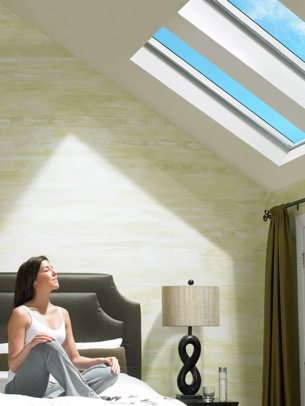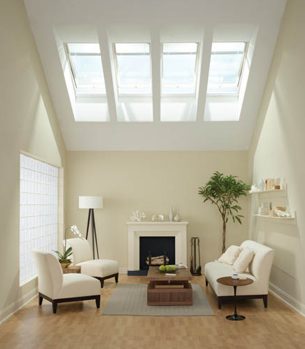Passive Solar Design: Skylight Windows
The goal of any passive solar green home design is to reduce energy usage in all its forms, including electric lighting and heating and cooling. New designs in skylight windows and roof windows can help achieve significant energy reductions in these areas.
Skylight Windows
Skylight Windows have been around for a long time to provide daytime lighting to interior spaces below, and have often been thought of as a luxury addition to a home. However, they are now considered a green feature, since they can be used to not only provide light but improve energy efficiency and overall comfort.
Skylight Windows and Passive Solar Energy
Providing natural light to interior spaces is the primary green feature of skylight windows, reducing the need for electric lighting during the daytime. But there are several factors to consider when looking at skylight windows as part of your green home design in order to maximize energy savings.
Skylight Windows - Orientation
Where you put a skylight window is the most important decision to make to increase energy savings. For example, a skylight window with a southern exposure will provide your home with passive solar heating in the winter months, reducing home heating costs.
Skylight windows should be shaded during the warm summer months with things like skylight shades or leafy trees outside to minimize heat gain and reduce air conditioning costs. A skylight on west-facing roofs is going to add to your cooling costs during the summer, as it captures the heat and energy of the hot afternoon and evening sun.
Also, if you have the perimeter of you home covered with perimeter glazing options, skylight windows are the perfect solution to bring natural lighting into the core living spaces of your home - if you have proper roof access that is. Adding skylight windows to these areas will significantly enhance the living space, bringing warmth and natural lighting to the space during the daylight hours.
Another popular option in utilizing skylight windows is supplementing natural lighting into work areas such as a kitchen island or a utility room. Also, give them a try in your master bathroom where you want natural lighting but wish to restrict views from to outside to these spaces.
Multi-Paned and Low-E Coating Skylight Windows
Improvements in skylight technologies in recent years have increased the efficiency of skylight windows. Upgrading from a single pane to a double pane skylight window can reduce heat loss by as much as 15 percent. This alone can add up to huge savings over the life of the skylight by keeping heated air during the winter months in the house rather than having it escape through the window.
Skylight windows with low-e coatings can also reduce heat loss in winter as well as reducing the amount of heat entering your home during the summer months. Depending on the climate your home is in, the right low e coating will optimize the performance of the skylight, balancing heat loss, solar gain and light transmission through the window. Investing in a skylight window which uses an inert gas such as argon or krypton in the space between layers of glazing or panes will also improve the thermal performance of the skylight.
Skylight windows should also be coated to filter UV rays in order to avoid damage to furniture and carpets caused by the sun's rays.
Low Conductivity Frame Skylight Windows
Investing in a quality skylight windows with low conductivity frames will also increase your home's energy efficiency. Aluminum and steel window frames have poor thermal performance, and should be avoided. Vinyl, wood, or fiberglass frames do a much better job at energy efficiency. Some frames are available with insulation in the hollow interiors, making the frame as efficient as possible.
comments powered by Disqus




























































































































































































